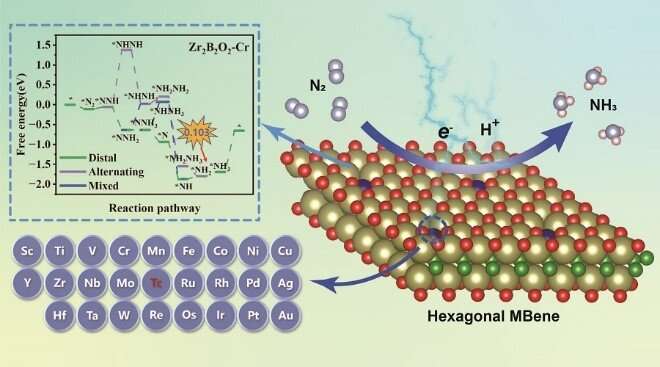Hexagonal MBene: A promising platform for the electrocatalytic nitrogen reduction reaction

A Chinese team has published new work in Energy Material Advances.
“In 2017, we reported a new family of 2D transition metal borides as analogs to MXenes and coined a catchy name for them, MBenes,” said paper author Zhimei Sun, professor of the School of Materials Science and Engineering at Beihang University.
“Up till now, MBenes have been widely studied as catalysts or substrates of various reactions, including HER, ORR/OER, NRR and CO2RR. Notably, the exploration of electrocatalytic performance for MBenes mainly focuses on those with orthorhombic structures, while there are few studies on applying the hexagonal MBenes (h-MBenes) as electrocatalysts.”
Sun explained that MBenes have several significant advantages as catalysts, such as excellent electrical conductivity, mechanical properties and electronic properties. Specifically, some researchers predicted that some MBenes with hexagonal phases would be more stable than their corresponding orthorhombic phases.
“It has been predicted that hexagonal Zr2B2 and Hf2B2 have the chance of being exfoliated, and the dynamic and thermal stabilities of Zr(Hf)2B2 have been verified in earlier investigations.”
“Moreover, they show good metallic conductivity to ensure electron transfer efficiency. And meanwhile, Zr2B2 exhibits high theoretical capacity and low migration energy barriers for Li+/Na+, demonstrating the great prospects of those predicted materials for electrochemical energy storage and conversion.”
However, as for electrocatalysts, the lack of active sites and effective charge centers is a major problem, making it difficult to activate reactants. Among various modified strategies, single-atom catalysts (SACs), which usually possess boosted reactivity and high selectivity toward specific products, provide an unprecedented opportunity for the development of electrocatalysts.
Specifically, it has been demonstrated that MBenes possess superb physical and chemical characteristics, which are highly desired as substrates for single-atom catalysts.
To explore the potential applications of hexagonal Zr2B2 and Hf2B2 as NRR electrocatalysts, Sun and her team systematically investigated the electrocatalytic NRR performance of a series of transition metal atoms (e.g. 3d, 4d, 5d) embedded in defective hexagonal MBene nanosheets (h-Zr(Hf)2B2O2) and identified that h-Zr(Hf)2B2O2 could be an excellent platform for electrocatalytic NRR.
“Based on our proposed screening criteria, 16 candidates were efficiently selected out from 50 systems, among which, Zr2B2O2-Cr stood out with high selectivity to NRR against HER as well as an ultra-low limiting potential (−0.10 V),” Sun said. “The value is significantly lower than that of the well-established stepped Ru (0001) surface (−0.43 V).”
“The origin of the high activity is attributed to the synergistic effect of the single atom (SA) and the M atoms in the substrate. More impressively, a composition descriptor was further proposed based on the inherent characteristics of the catalysts (number of valence electrons of SAs, electronegativity of the SAs and Zr(Hf) atoms), which helps to better predict the catalytic performance.”
This work not only identified efficient NRR electrocatalysts, but also paves a new pathway in the application of h-MBenes, which will trigger more efforts to develop this novel 2D material experimentally and theoretically.
More information:
Ya Gao et al, Hexagonal MBenes-Supported Single Atom as Electrocatalysts for the Nitrogen Reduction Reaction, Energy Material Advances (2023). DOI: 10.34133/energymatadv.0039
Provided by
Beijing Institute of Technology Press Co., Ltd
Citation:
Hexagonal MBene: A promising platform for the electrocatalytic nitrogen reduction reaction (2023, July 7)
retrieved 7 July 2023
from https://phys.org/news/2023-07-hexagonal-mbene-platform-electrocatalytic-nitrogen.html
This document is subject to copyright. Apart from any fair dealing for the purpose of private study or research, no
part may be reproduced without the written permission. The content is provided for information purposes only.
For all the latest Science News Click Here
For the latest news and updates, follow us on Google News.

